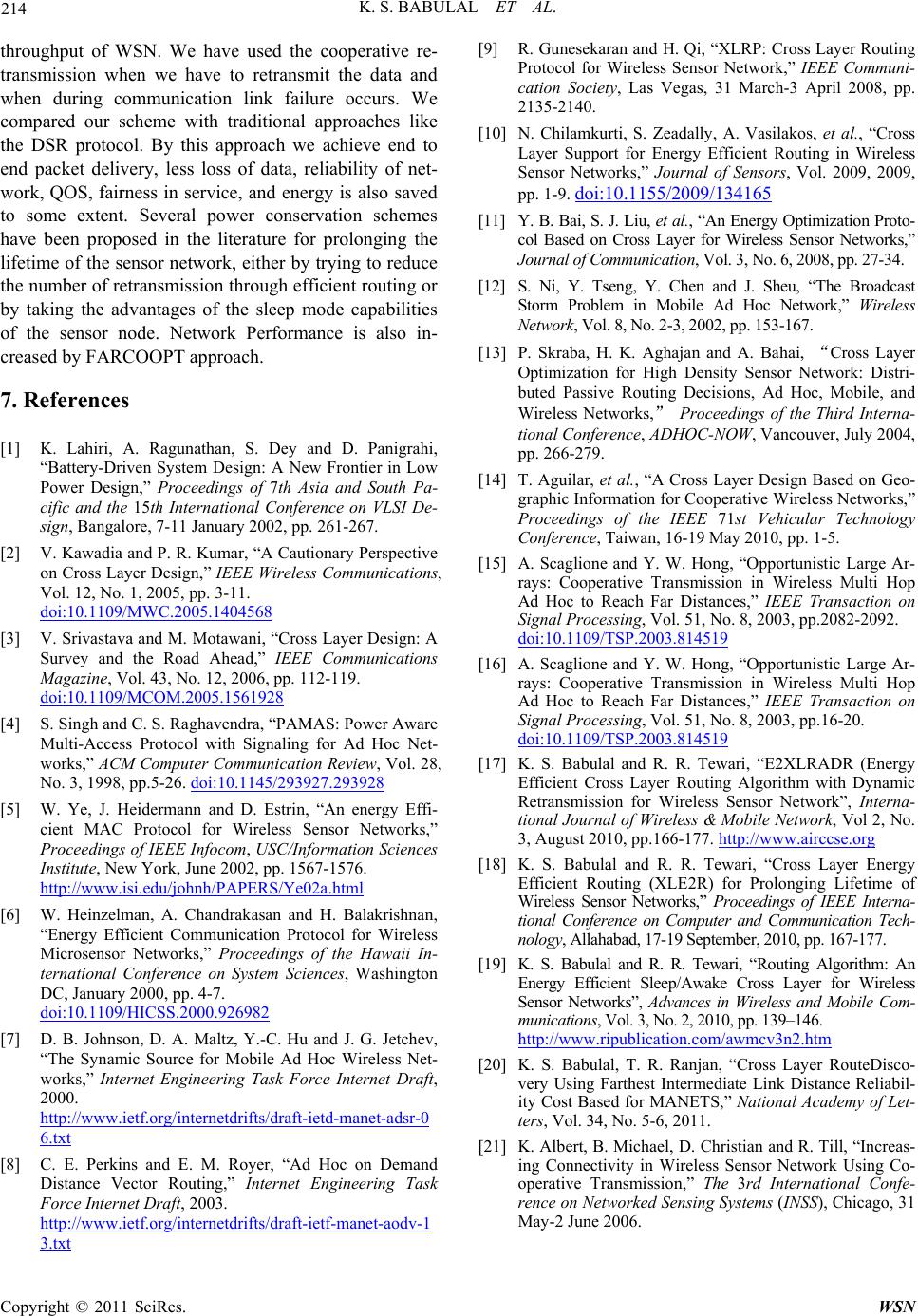
K. S. BABULAL ET AL.
Copyright © 2011 SciRes. WSN
throughput of WSN. We have used the cooperative re-
transmission when we have to retransmit the data and
when during communication link failure occurs. We
compared our scheme with traditional approaches like
the DSR protocol. By this approach we achieve end to
end packet delivery, less loss of data, reliability of net-
work, QOS, fairness in service, and energy is also saved
to some extent. Several power conservation schemes
have been proposed in the literature for prolonging the
lifetime of the sensor network, either by trying to reduce
the number of retransmission through efficient routing or
by taking the advantages of the sleep mode capabilities
of the sensor node. Network Performance is also in-
creased by FARCOOPT approach.
7. References
[1] K. Lahiri, A. Ragunathan, S. Dey and D. Panigrahi,
“Battery-Driven System Design: A New Frontier in Low
Power Design,” Proceedings of 7th Asia and South Pa-
cific and the 15th International Conference on VLSI De-
sign, Bangalore, 7-11 January 2002, pp. 261-267.
[2] V. Kawadia and P. R. Kumar, “A Cautionary Perspective
on Cross Layer Design,” IEEE Wireless Communications,
Vol. 12, No. 1, 2005, pp. 3-11.
doi:10.1109/MWC.2005.1404568
[3] V. Srivastava and M. Motawani, “Cross Layer Design: A
Survey and the Road Ahead,” IEEE Communications
Magazine, Vol. 43, No. 12, 2006, pp. 112-119.
doi:10.1109/MCOM.2005.1561928
[4] S. Singh and C. S. Raghavendra, “PAMAS: Power Aware
Multi-Access Protocol with Signaling for Ad Hoc Net-
works,” ACM Computer Communication Review, Vol. 28,
No. 3, 1998, pp.5-26. doi:10.1145/293927.293928
[5] W. Ye, J. Heidermann and D. Estrin, “An energy Effi-
cient MAC Protocol for Wireless Sensor Networks,”
Proceedings of IEEE Infocom, USC/Information Scie nces
Institute, New York, June 2002, pp. 1567-1576.
[6] W. Heinzelman, A. Chandrakasan and H. Balakrishnan,
“Energy Efficient Communication Protocol for Wireless
Microsensor Networks,” Proceedings of the Hawaii In-
ternational Conference on System Sciences, Washington
DC, January 2000, pp. 4-7.
http://www.isi.edu/johnh/PAPERS/Ye02a.html
doi:10.1109/HICSS.2000.926982
[7] D. B. Johnson, D. A. Maltz, Y.-C. Hu and J. G. Jetchev,
“The Synamic Source for Mobile Ad Hoc Wireless Net-
works,” Internet Engineering Task Force Internet Draft,
2000.
[8] C. E. Perkins and E. M. Royer, “Ad Hoc on Demand
Distance Vector Routing,” Internet Engineering Task
Force Internet Draft, 2003.
http://www.ietf.org/internetdrifts/draft-ietd-manet-adsr-0
6.txt
[9] R. Gunesekaran and H. Qi, “XLRP: Cross Layer Routing
Protocol for Wireless Sensor Network,” IEEE Communi-
cation Society, Las Vegas, 31 March-3 April 2008, pp.
2135-2140.
http://www.ietf.org/internetdrifts/draft-ietf-manet-aodv-1
3.txt
[10] N. Chilamkurti, S. Zeadally, A. Vasilakos, et al., “Cross
Layer Support for Energy Efficient Routing in Wireless
Sensor Networks,” Journal of Sensors, Vol. 2009, 2009,
pp. 1-9.
[11] Y. B. Bai, S. J. Liu, et al., “An En ergy Optimiza tion Proto-
col Based on Cross Layer for Wireless Sensor Networks,”
Journal of Communication, Vol. 3, No. 6, 2008, pp. 27-34.
doi:10.1155/2009/134165
[12] S. Ni, Y. Tseng, Y. Chen and J. Sheu, “The Broadcast
Storm Problem in Mobile Ad Hoc Network,” Wireless
Netwo rk, Vol. 8, No. 2-3, 2002, pp. 153-167.
[13] P. Skraba, H. K. Aghajan and A. Bahai, “Cross Layer
Optimization for High Density Sensor Network: Distri-
buted Passive Routing Decisions, Ad Hoc, Mobile, and
Wireless Networks,” Proceedings of the Third Interna-
tional Conference, ADHOC-NOW, Vancouver, July 2004,
pp. 266-279.
[14] T. Aguilar, et al., “A Cross Layer Design Based on Geo-
graphic Information for Cooperative Wireless Networks,”
Proceedings of the IEEE 71st Vehicular Technology
Conference, Taiwan, 16-19 May 2010, pp. 1-5.
[15] A. Scaglione and Y. W. Hong, “Opportunistic Large Ar-
rays: Cooperative Transmission in Wireless Multi Hop
Ad Hoc to Reach Far Distances,” IEEE Transaction on
Signal Processing, Vol. 51, No. 8, 2003, pp.2082-2092.
[16] A. Scaglione and Y. W. Hong, “Opportunistic Large Ar-
rays: Cooperative Transmission in Wireless Multi Hop
Ad Hoc to Reach Far Distances,” IEEE Transaction on
Signal Processing, Vol. 51, No. 8, 2003, pp.16-20.
doi:10.1109/TSP.2003.814519
doi:10.1109/TSP.2003.814519
[17] K. S. Babulal and R. R. Tewari, “E2XLRADR (Energy
Efficient Cross Layer Routing Algorithm with Dynamic
Retransmission for Wireless Sensor Network”, Interna-
tional Journal of Wireless & Mobile Network, Vol 2, No.
3, August 2010, pp.166-177. http://www.airccse.org
[18] K. S. Babulal and R. R. Tewari, “Cross Layer Energy
Efficient Routing (XLE2R) for Prolonging Lifetime of
Wireless Sensor Networks,” Procee di ng s of IEEE Interna-
tional Conference on Computer and Communication Tech-
nology, Allahabad, 17-19 September, 2010, pp. 167-177.
[19] K. S. Babulal and R. R. Tewari, “Routing Algorithm: An
Energy Efficient Sleep/Awake Cross Layer for Wireless
Sensor Networks”, Advances in Wireless and Mobile Com-
munications, Vol. 3, No. 2, 2010, pp. 139–146.
http://www.ripublication.com/awmcv3n2.htm
[20] K. S. Babulal, T. R. Ranjan, “Cross Layer RouteDisco-
very Using Farthest Intermediate Link Distance Reliabil-
ity Cost Based for MANETS,” National Academy of Let-
ters, Vol. 34, No. 5-6, 2011.
[21] K. Albert, B. Michael, D. Christian and R. Till, “Increas-
ing Connectivity in Wireless Sensor Network Using Co-
operative Transmission,” The 3rd International Confe-
rence on Networked Sensing Systems (INSS), Chicago, 31
May-2 June 2006.